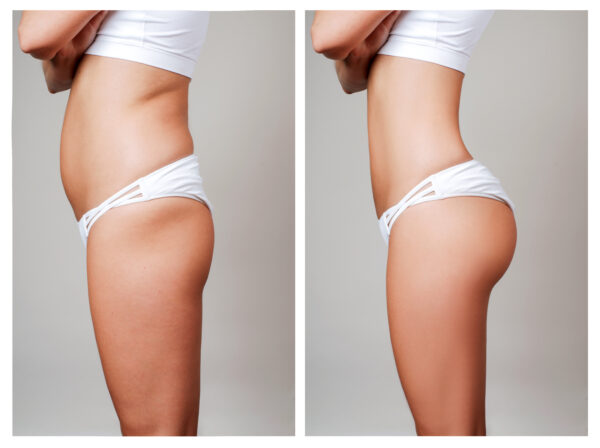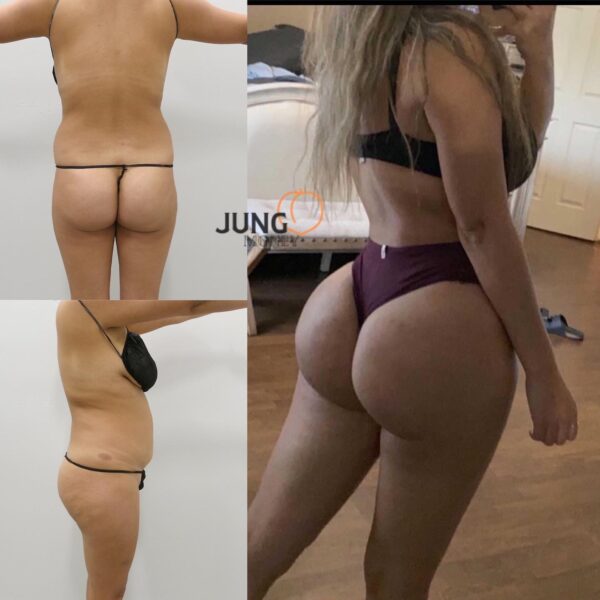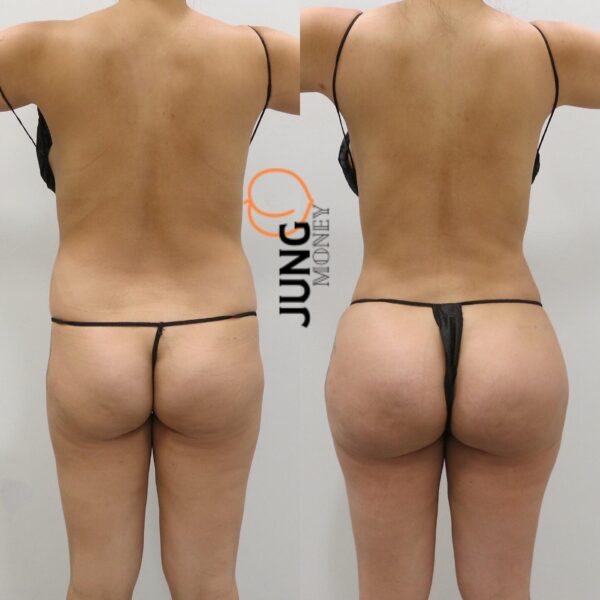Description
Familiarity with treatment
A Mini BBL is a variation of the traditional Brazilian Butt Lift procedure that focuses on enhancing the shape and volume of the buttocks using a smaller amount of fat transfer.
In a Mini BBL, the surgeon typically performs liposuction on specific areas of the body, such as the abdomen, flanks, or thighs, to harvest a smaller amount of fat. The harvested fat is then processed and purified before being injected into the buttocks to enhance their shape and volume.
The Mini BBL is often chosen by individuals who have a smaller amount of excess fat available for transfer or those who desire a more subtle enhancement of their buttocks. It can provide a more proportionate and lifted appearance to the buttocks while still maintaining a natural look.
Who is it suitable for?
A Mini Brazilian Butt Lift (BBL) may be suitable for individuals who:
- Desire a subtle enhancement: The Mini BBL is ideal for individuals who are looking for a more modest improvement in the shape and volume of their buttocks. It can provide a natural-looking enhancement without dramatically altering the overall appearance.
- Have a smaller amount of excess fat: The Mini BBL requires a smaller amount of fat for transfer compared to traditional BBL procedures. It is suitable for individuals who have a limited amount of excess fat in areas such as the abdomen, flanks, or thighs that can be harvested for transfer to the buttocks.
- Want a shorter recovery period: The Mini BBL typically involves a smaller incision and less extensive liposuction compared to traditional BBL procedures. This can result in a shorter recovery period, allowing individuals to return to their normal activities sooner.
- Have good skin elasticity: The success of a Mini BBL relies on the ability of the skin to adapt to the new shape and volume of the buttocks. Individuals with good skin elasticity are more likely to achieve optimal results from the procedure.
- Have realistic expectations: It is important for individuals considering a Mini BBL to have realistic expectations about the potential outcomes. While the procedure can enhance the shape and volume of the buttocks, the results may be more subtle compared to traditional BBL procedures.
- Are in good overall health: Like any surgical procedure, it is important for individuals considering a Mini BBL to be in good overall health. They should disclose any medical conditions, allergies, or medications they are taking to their plastic surgeon to ensure the procedure is safe for them.
Who is it not suitable for?
A Mini Brazilian Butt Lift (BBL) may not be suitable for certain individuals, including:
- Insufficient fat for transfer: The Mini BBL requires a certain amount of excess fat in other areas of the body for liposuction and transfer to the buttocks. If an individual does not have enough fat available for transfer, a traditional BBL or alternative buttock augmentation procedure may be more appropriate.
- Significant sagging or loose skin: The Mini BBL primarily focuses on enhancing the shape and volume of the buttocks through fat transfer. It may not effectively address significant sagging or loose skin in the buttock area. In such cases, a surgical procedure like a traditional BBL or a buttock lift may be more suitable.
- Unrealistic expectations: It is important for individuals considering a Mini BBL to have realistic expectations about the potential outcomes. The procedure can provide a subtle enhancement, but it may not achieve dramatic changes in buttock size or shape. If someone has unrealistic expectations, they may not be satisfied with the results of a Mini BBL.
- Pregnancy or breastfeeding: It is generally recommended to avoid cosmetic procedures, including BBL, during pregnancy and while breastfeeding. Hormonal changes and the body’s natural processes during this time can affect the results and safety of the procedure.
- Certain medical conditions or contraindications: Certain medical conditions or factors may make a Mini BBL unsuitable or risky. These may include bleeding disorders, active infections, autoimmune diseases, allergies to anesthesia or medications used during the procedure, or a history of adverse reactions to liposuction or fat transfer.
Advantages
The Mini Brazilian Butt Lift (BBL) offers several advantages compared to traditional BBL procedures. Here are some potential advantages of a Mini BBL:
- Subtle enhancement: The Mini BBL is designed to provide a more modest enhancement to the shape and volume of the buttocks. It can create a natural-looking result that enhances the overall appearance without dramatically altering the proportions.
- Less extensive liposuction: The Mini BBL requires a smaller amount of fat for transfer compared to traditional BBL procedures. This means that the liposuction process is less extensive, resulting in smaller incisions and potentially a shorter recovery period.
- Shorter recovery time: Due to the less extensive liposuction and smaller incisions involved, the recovery time for a Mini BBL may be shorter compared to traditional BBL procedures. This can allow individuals to return to their normal activities sooner.
- Reduced scarring: The smaller incisions used in a Mini BBL can result in smaller and less noticeable scars compared to traditional BBL procedures. This can be particularly beneficial for individuals who are concerned about visible scarring.
- Lower risk of complications: The Mini BBL generally involves less extensive surgical manipulation compared to traditional BBL procedures. This can potentially reduce the risk of complications such as infection, bleeding, or adverse reactions to anesthesia.
- Customizable results: Just like traditional BBL procedures, the Mini BBL can be customized to suit the individual’s specific goals and preferences. The surgeon can tailor the procedure to achieve the desired shape and volume while maintaining a natural appearance.
- More suitable for individuals with less fat: The Mini BBL is a suitable option for individuals who have a smaller amount of excess fat available for transfer. It can still provide noticeable enhancement even with a limited fat supply.
Complications
The Mini Brazilian Butt Lift is a less invasive version of the traditional Brazilian Butt Lift procedure. While it is generally considered safe, like any surgical procedure, there are potential complications that can arise. Some possible complications of a Mini Brazilian Butt Lift include:
- Infection: There is a risk of infection at the incision sites or in the injected fat. This can be minimized by following proper post-operative care instructions and taking prescribed antibiotics.
- Bleeding: Excessive bleeding can occur during or after the procedure. Surgeons take precautions to minimize bleeding, but it is still a potential risk.
- Fat embolism: In rare cases, fat can enter the bloodstream and travel to other parts of the body, causing a fat embolism. This can be a serious and potentially life-threatening complication.
- Seroma: A seroma is a collection of fluid that can accumulate under the skin after surgery. It may require drainage to prevent infection and promote healing.
- Scarring: While efforts are made to minimize scarring, there is always a risk of visible scars at the incision sites.
- Asymmetry: There is a possibility of uneven or asymmetrical results, where one buttock may appear larger or have a different shape than the other.
- Skin irregularities: The injected fat may not be evenly distributed, leading to lumps, bumps, or uneven texture in the buttocks.
- Allergic reactions: Some individuals may have an allergic reaction to the anesthesia, medications, or materials used during the procedure.
- Nerve damage: There is a risk of nerve damage during the surgery, which can result in numbness, tingling, or loss of sensation in the buttocks or surrounding areas.
It is important to discuss these potential complications with your surgeon before undergoing any surgical procedure. They can provide you with more detailed information and help you make an informed decision.
Preoperative care
Preoperative care refers to the steps and precautions taken before a surgical procedure to ensure the best possible outcome and minimize the risk of complications. Here are some general preoperative care guidelines that may apply to a Mini Brazilian Butt Lift or any surgical procedure:
- Medical evaluation: Before the surgery, you will undergo a thorough medical evaluation. This may include a physical examination, blood tests, and other diagnostic tests to assess your overall health and identify any underlying medical conditions that may affect the surgery or anesthesia.
- Medication review: Inform your surgeon about all the medications you are currently taking, including prescription medications, over-the-counter drugs, and supplements. Some medications may need to be adjusted or temporarily stopped before the surgery to reduce the risk of bleeding or other complications.
- Smoking cessation: If you are a smoker, it is strongly recommended to quit smoking at least a few weeks before the surgery. Smoking can impair healing and increase the risk of complications.
- Avoid certain substances: Your surgeon may advise you to avoid alcohol, recreational drugs, and certain herbal supplements in the weeks leading up to the surgery, as they can interfere with anesthesia or increase the risk of bleeding.
- Fasting: You will likely be instructed to fast for a certain period of time before the surgery. This is to ensure that your stomach is empty, reducing the risk of aspiration during anesthesia.
- Arrange transportation and support: Since you will be undergoing a surgical procedure, it is important to arrange for someone to drive you to and from the hospital or surgical center. You may also need assistance with daily activities during the initial recovery period.
- Follow instructions: Your surgeon will provide you with specific instructions to follow before the surgery. This may include guidelines on when to stop eating and drinking, what medications to take or avoid, and how to prepare the surgical site.
- Mental and emotional preparation: It is normal to feel anxious or nervous before surgery. Take time to mentally and emotionally prepare yourself by asking questions, discussing any concerns with your surgeon, and seeking support from loved ones.
Postoperative care
Postoperative care refers to the steps and precautions taken after a surgical procedure to promote healing, manage pain, and minimize the risk of complications. Here are some general postoperative care guidelines that may apply to a Mini Brazilian Butt Lift or any surgical procedure:
- Follow surgeon’s instructions: Your surgeon will provide you with specific postoperative instructions. It is important to follow these instructions closely to ensure proper healing and minimize the risk of complications. This may include guidelines on wound care, medication management, activity restrictions, and follow-up appointments.
- Pain management: You may experience some pain and discomfort after the surgery. Your surgeon will prescribe pain medications or recommend over-the-counter pain relievers to manage your pain. Take the medications as directed and report any severe or persistent pain to your surgeon.
- Wound care: Proper wound care is essential for preventing infection and promoting healing. Your surgeon will provide instructions on how to clean and dress the incision sites. Follow these instructions carefully and report any signs of infection, such as increased redness, swelling, or drainage, to your surgeon.
- Compression garments: Your surgeon may recommend wearing compression garments or special garments to support the newly shaped buttocks and help reduce swelling. Follow your surgeon’s instructions on when and how to wear these garments.
- Rest and activity restrictions: It is important to get plenty of rest and avoid strenuous activities during the initial recovery period. Your surgeon will provide guidelines on when you can gradually resume normal activities, including exercise and lifting heavy objects.
- Nutrition and hydration: Eating a healthy diet and staying hydrated can support the healing process. Follow any dietary recommendations provided by your surgeon and drink plenty of fluids, unless otherwise instructed.
- Avoid smoking and alcohol: Smoking and alcohol can impair healing and increase the risk of complications. It is best to avoid smoking and limit alcohol consumption during the recovery period.
- Emotional support: Recovery from surgery can be physically and emotionally challenging. Seek support from loved ones, join support groups, or consider counseling if needed.
- Follow-up appointments: Attend all scheduled follow-up appointments with your surgeon. These appointments are important for monitoring your progress, removing stitches if necessary, and addressing any concerns or complications that may arise.
Only logged in customers who have purchased this product may leave a review.







Reviews
There are no reviews yet.